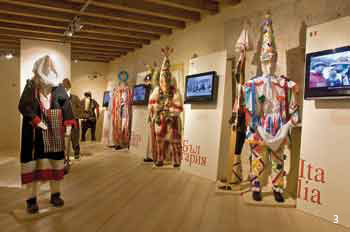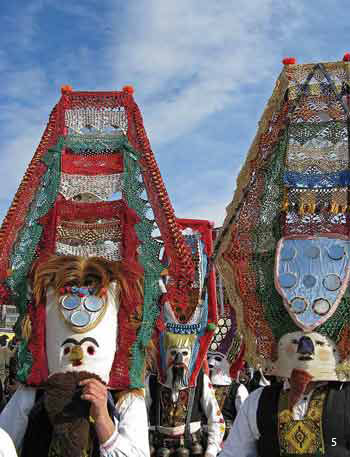CARNIVAL KING OF EUROPE:common traits in European awareness of the Continent’s various culturesGiovanni Kezich
|
|||
“A spectre is haunting Europe”… and, surprisingly, it’s the ghost of Carnival time: the ancient masked scoundrel that, come rain or shine, has passed through the streets of our continent in the height of winter since time immemorial; through cities and towns, from the remotest countryside to the furthest and most inaccessible mountain villages … Indeed, if you look at a map of Europe, whether it be this side or the other, you’ll be amazed at how varied the ways of celebrating Carnival can be every time, and all within just a few kilometres of each other. Take the Trentino region for example: the Central-Oriental Alps, close to the heart of the Dolomites, is home to an impressive variety of very different carnivals, which from time to time include: scary masks adorned with bells, sacred harlequins -white-clad and dancing -then the jokers, the foul-mouthed scoundrels emerging from their peasant past -a true kaleidoscope of costumes and masks, all from different influences. If we change our scope, however, and we enlarge our visual field to encompass the entire Alpine area and then, gradually, the entire European continent, our first impression of there being great differences between local carnival celebrations completely changes. In fact, what we notice is the opposite: what stands out to us is a surprising continuity in how people celebrate Carnival the width and breadth of the Old Country -from the Pyrenees to the Balkans via peninsular and insular Italy, the Alps and Central Europe. And so we find that, more or less everywhere, but particularly in the remotest mountain and countryside villages, where perhaps more effort is made to keep traditions as they are, what we call “Carnival” is actually a well-structured ritual procession that, |
 |
||
 |
with its own characters and its own predetermined performances, follows a series of specific stages. For example, almost everywhere, the parade acts as a sort of “collection plate” in that the masks, although frightening and intrusive at first, go around houses and the tiniest suburbs of larger neighbouring towns, wishing prosperity and well-being fortheagricultural yearaheadinexchange for eggs, cakes, wine, flour, or even money. With the wealth that we have come to know today, this “collection plate” has, in some instances, become a round of treats, with a table set at every farm or district in eager anticipation of the arrival of the masks. This is something you still find today in Bulgarian Thrace in the Macedonian countryside, but also closer to home: take the Italian Alps, for example, Valfloriana in Trentino or the Coumba Freida in Valle d’Aosta, the French Basque Country and in the Soule valley. But who do these masks represent? Almost everywhere in Europe, we can start with those that represent an ancestral pastoral world; an ancient flock returning from a long oblivion spent in the vast wild surrounding the village, covered in fleece and sporting horns or long beards, their arrival announced without fail by the clanging of the bells tied around their bodies. In Basque language, in Spanish Navarre, these characters are said to be joaldunak (“bell ringers”), just like the similarly costumed characters you find in inland Fiume, Croatia -the zvončari -again meaning “bell ringers”. |
||
| If we apply “Ariadne’s thread” to the names that bind half of Europe’s carnival characters, we cancome up with some interesting discoveries. To cite an example, the lesserknown name of the Croatian bell ringers, the zvončari, is stari (the “ancient”), just like the “ancient” protagonists -clearly alluding to their ancestors and thus to the world of the dead -of the Mòcheni Valley carnival. These “ancients” wear pointy goat hair hats adorned with ribbons, faces smeared with a black grease that also covers the long sticks they hold in their hands: this is exactly the same mask as the protagonist of the carnival of Prats-de-Mollo-la-Preste, a western Pyrenees village in French Catalonia where, instead, it is known as “the bear”. Bears and bear hunting are a feature of Carnival occasions in the Occitan Valleys of Piedmont, in the Fiemme Valley up until just a few years ago, in the Habsburgs in Central Europe and throughout the Balkans galore. Let’s now take another road. Who hasn’t heard of the famous Sardinian mamuthones from Mamoiada? These too are androgynous and ancient Carnival bell ringers. From just one glance at a linguistic atlas, you’ll see that their mysterious other name is none other than “big dolly” or “puppet”: the same local name given to scarecrows planted in the middle of fields to discourage birds from disturbing crops. However, the scarecrow name coincides with that of a widespread Alpine carnival character, which, no matterwhere, has one ofa series of names stemming from mato: matòch, matòcio, matazìn... A puppet planted in the middle of a barley or wheat field, or better, a personified and somehow spiritualised sheaf that takes us back to the remote agrarian roots of these cults: |
 |
||
 |
|||
1. Matòcio, Matòcio, Valfloriana, Carnival 2006 |
so much so that, at the climax of the carnival parade the main part of the ritual, alongside the almost mandatory pretend-marriage – there is the ritual ploughing, which we still find today from the Balkans to the Alps, from Sardinia to Navarre… As we can see, we already have more than enough examples to allow for a European study that would examine, verify and uncover meanings, analogies and the surprising identities of various characters and events, from one end of the continent to the other and going down as many avenues as possible. It was the Museum of Uses and Customs of the Trentino People in San Michele all’Adige that came up with the idea, stemming from their lengthy first-hand experience of the great wealth of carnival tradition nestled at the foot of the Dolomites. For its first phase, it has received the backing of four major museums from four European countries: the Zagreb Ethnographic Museum in Croatia, The National Ethnographic Museum of Sofia in Bulgaria, the National Ethnographic Museum in Skopje, Macedonia, and the Museum of Civilisations from Europe and the Mediterranean in Marseille, France. The project, entitled Carnival King of Europe/Carnevale Re d’Europa, has won the support of the EU Department for Culture for the 2007/2009 biennium, and has, to date, produced some important study seminars, a website www.carnivalkingofeurope.it, field research in the five countries involved, and an exhibition that was opened in San Michele all’Adige (November 22nd 2008), and then moved to Zagreb (January 15th 2009), Sofia (March 19th 2009), Skopje (May 16th 2009), and coming soon to Marseille. This is a real journey, that we are continuing on today, to discover Europe’s cultural roots: to date, and from an ethnological point of view, the most mysterious and least known of all the five continents. |
||
 Via Mach, 238010 San Michele all‘Adige Tel +39 0461 650314Fax +39 0461 650703 www.museosanmichele.it |
|||
© 2006-2009 EcodelleDolomiti |
